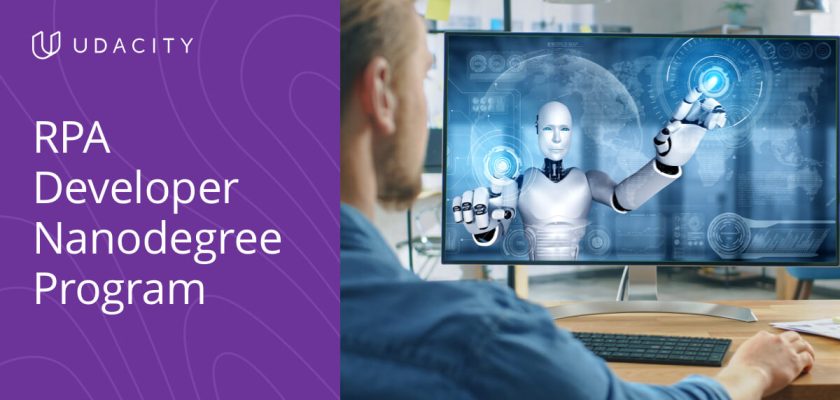Download and Learn Become an RPA Developer Udacity Nanodegree Course 2023 for free with google drive download link.
Build the operational processes that enable the businesses of the future.
In collaboration with

What You’ll Learn in Become an RPA Developer Nanodegree

RPA Developer
Estimated 4 Months to complete
The RPA Developer Nanodegree Program helps students develop professional-level skills focused on developing and deploying software robots. You will learn basic RPA concepts and how to use the UiPath RPA software platform to automate business processes while refreshing basic programming skills along the way.
Become an RPA Developer Intro Video:
Prerequisite knowledge
Basic familiarity with Microsoft applications and data manipulation
A well-prepared learner is already able to:
- Use Microsoft applications, understand data manipulation, and understand basic logical sequence flows (like Visio)
While the following experience is not required to complete the Nanodegree program, students may benefit from:
- Proficiency in a programming language and scripting in a programming language to review, implement, and modify code; VB.NET/VBA/C# experience is a plus
- An understanding of the .NET framework
A student must have access to a Windows-based machine with Microsoft applications like Excel and Outlook or a VM running a Windows environment. Specific minimum hardware and software requirements:
- CPU: 2 x 1.8GHz 32-bit (x86)
- RAM: 4 GB
- Windows 7+, Chrome, and Microsoft Office
- For more information on the recommended hardware requirements or other versions of software, you can go to UiPath Hardware and Software Requirements
Intro to RPA with UiPath
In this course, you will learn about RPA using UiPath, specifically how to use UiPath Studio to develop automation solutions. You’ll first get a deep dive into Studio and how to use activities to program the robot to mimic actions. You’ll understand how data is stored and passed between applications and actions while understanding the logical flow of execution of the actions. Finally, you’ll learn about selectors, which are the heart of user interface identification and automation and how the robots use them to work within UI applications to successfully identify where to enter or extract data and actions.
Project – Sorting Annual Reports
You are tasked with organizing several annual reports from your company, but you want to be able to create an automation so that you can just click one button and automatically sort future reports! You will be given a webpage where all the reports are currently stored and will create an automation to sort them based on the name of the reports.
UiPath Advanced Automation Techniques and Design
In this course, you’ll cover more advanced automation techniques to make you confident automating various software, web applications, and beyond. You’ll learn how to extract, manipulate, and insert data within Excel and PDF documents, and about the recording options in Studio to assist you in quickly building automation projects. In addition, you’ll learn how to implement debugging techniques to ensure your code is free from errors and runs end to end. And finally, you’ll be introduced to UiPath Orchestrator, a web based management tool, so you can manage your projects and use the developer functionalities to make your projects robust and scalable.
Project – Invoice Scraping
In this project, you will develop an automation for a process that will scrape data from and then process invoices. Your robot will read through emails and download the invoices received in the form of an email attachment. It will extract specific data and store those values in an Excel spreadsheet and a subset of values will be uploaded to the Orchestrator Queue. And finally, the robot will email the spreadsheet to you when finished.
RPA Team Best Practices
This course will give you the tools you need to handle unexpected challenges with consistent and successful methods. First, you’ll understand how to identify and handle common challenges with RPA projects. Then, you’ll learn the best way to design solutions and have clean, organized project solutions. You’ll learn standard best practices to ensure you consider the most important aspects to well written code in Studio. Next, you’ll cover an advanced topic, the Robotic Enterprise Framework, which is necessary for production level projects. Finally, you’ll understand how RPA teams work together, how automation is an end-to-end process, and how it relates to AI and other technologies, as well as how to learn more and connect with the RPA community.
Project – RPA Code Review
As an RPA developer, you will often be called on by other RPA developers on your team to review their work. Team members review each other’s code routinely before completing the end-to-end automation solution. As the RPA developer leading the project, it is your job to finish the DSD when the development and testing is done for hand-off to the COE.
Project – Capstone Project: Personal Use Automation
In the capstone project, you will apply the skills you have developed throughout this RPA Developer Nanodegree program to build an automation of a process in your professional or personal life. To ensure your process is impactful and a good use case for your portfolio, it will have to be a process which interacts with multiple applications, contains data manipulation, handles errors and exceptions, and has good design and reusable components. First, you will fill out all the necessary steps of the process and any requirements in the Process Definition Document (PDD). Then, you will design and build the automated solution in UiPath Studio. Finally, you will create the resulting Development Specifications Document (DSD) showcasing your solution and any dependencies needed to run it.
RPA is the fastest-growing segment of the enterprise software market.

